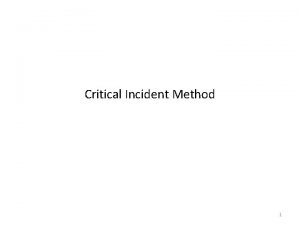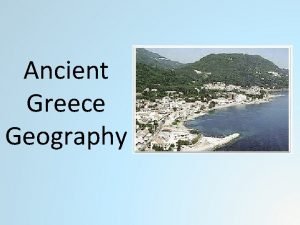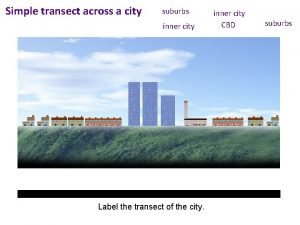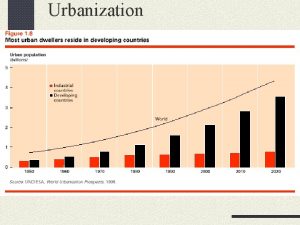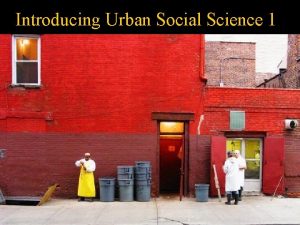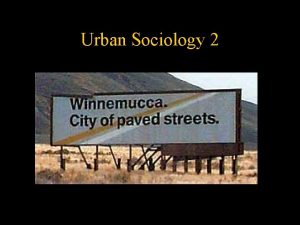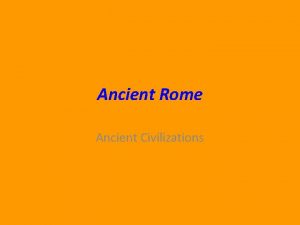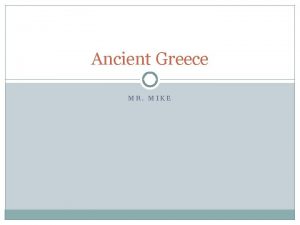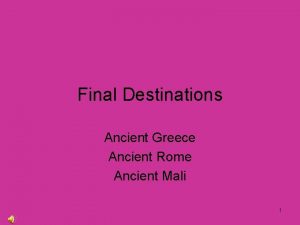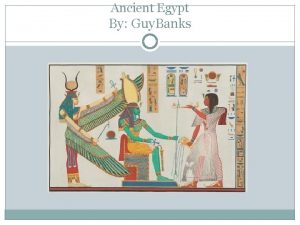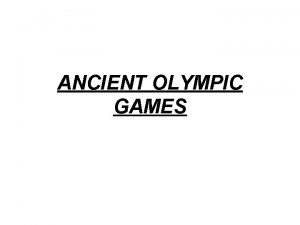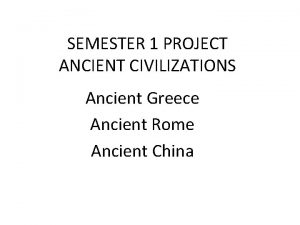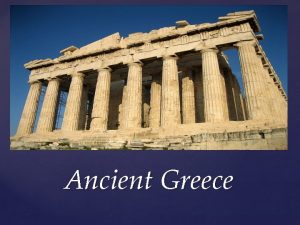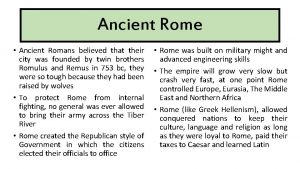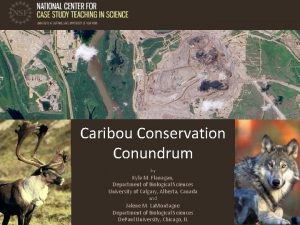The Ancient City The Ancient City Reading Flanagan

































- Slides: 33

The Ancient City

The Ancient City • Reading: Flanagan Ch 2

Why study historic cities? • Gives us examples of cities other then our own • Brings us to consider the fundamentals of what makes a city

Emergence of Urban Form • Connected to transition of humans from hunting & gathering to settled agricultural life

Emergence of Urban Form • Settled agricultural life: – Old world: begins c. 10, 000 years ago (YBP) – New world: begins 2, 000 YPB

Emergence of Urban Form • Old World: – 5, 300 -5, 500 YBP Mesopotamia, Indus valley • New World: – 1, 700 YBP

First Cities • Mesopotamia: Southern Iraq, Tigris & Euphrates rivers: Ur, • Indus valley: Harrapa, Mohenjo-Daro etc. ,


First Cities • Cities emerge after long pre-urban period of settled agricultural life • Cities emerge before writing

Exception: Catal Huyuk • • urban almost 10, 000 YBP pre-agricultural 5 -10, 000 population based on mining and trade in obsidian

First Cities • Very rapid emergence of sophisticated urban civilizations – writing – complex buildings – skilled craftsmen – luxury items – long-distance trade

First Cities • Small by modern standards – 10, 000 was a big one • Ancient monster cities: – Classical Athens: 300, 000 – Classical Rome: 650, 000

Why were they so small? • Large cities require: – large empire to feed and supply them – complex, but effective organization – significant military forces


World Urban Population

First Cities • Distinguished by urban forms of social organization – numerous people in specialised non-rural occupations – social stratification & differences in status – emergence of urban social organization

First Cities • Key issue is urban social organization • Can be fairly rural in setting: – Mayan cities

First Cities • Stark social contrasts: – god-King, priest – craftsmen – slaves

First Cities • Places where power was projected – social – religious – military – economic • Connected with monumental structures – helped to project the power?

• Giza

• Bayon, Cambodia

First Cities • Connected to the emergence of states – projection of political power – urban control over rural populations

First Cities • need to control rural territories – obtain food, slaves – collect “taxes”

Classical Greece • Complex long-distance trading networks • Expensive iron technology vital to warfare

Classical Greece • Kings relied on wealthy farmers, merchants to provide the army • Power of kings diminished, power fell into the hands of farmers & merchants – Democracy

Theories of Urban Origins • • Childe theory Trade theory Wittfogel’s Hydraulic theory Pivot and Four Quarters

Childe Theory • V Gordon Childe • Technology allows – accumulation of surpluses – increased production • Leads to more complex social organization – cities

Trade Theory • Braidwood • Cities emerge out of complex trading routes – Catal Huyuk

Hydraulic Theory • Karl Wittfogel • First cities emerge in agricultural regions dependent on irrigation • City states developed as means of organizing irrigation schemes, agriculture – OK in Mesoptamia, doesn’t work in Egypt

Pivot & Four Quarters • Paul Wheatley • Religious activity is the key factor • Cities emerge as key control points, temple locations, centres receiving religious tributes – Works, especially in China, Mesoamerica, but annoys the Marxists


Synoecism • Rural area gradually evolves into an urban one • If rural develops urban social organization • Gradually transformed – ancient Athens, Rome – rural district surrounding fortified temple/refuge site

Urban Origins • Probably many ways in which cities can emerge
 Pre reading while reading and post reading activities
Pre reading while reading and post reading activities Pengertian tes bakat
Pengertian tes bakat Tammy flanagan medicare
Tammy flanagan medicare Cormac flanagan
Cormac flanagan Incident method
Incident method Mark flanagan wilmerhale
Mark flanagan wilmerhale Stephanie flanagan
Stephanie flanagan Means of communication from ancient to modern
Means of communication from ancient to modern Ancient india vs ancient china
Ancient india vs ancient china Round robin reading vs popcorn reading
Round robin reading vs popcorn reading Aims and objectives of teaching
Aims and objectives of teaching While reading stage
While reading stage Reading strategies edb
Reading strategies edb It is an active process of discovery.
It is an active process of discovery. Intensive reading and extensive reading
Intensive reading and extensive reading Intensive and extensive reading
Intensive and extensive reading How to develop reading skills in students
How to develop reading skills in students 8
8 Huntsville city school summer reading
Huntsville city school summer reading City model
City model Cbd inner city suburbs
Cbd inner city suburbs Is mexico city a primate city
Is mexico city a primate city Hát kết hợp bộ gõ cơ thể
Hát kết hợp bộ gõ cơ thể Bổ thể
Bổ thể Tỉ lệ cơ thể trẻ em
Tỉ lệ cơ thể trẻ em Gấu đi như thế nào
Gấu đi như thế nào Glasgow thang điểm
Glasgow thang điểm Chúa sống lại
Chúa sống lại Môn thể thao bắt đầu bằng từ chạy
Môn thể thao bắt đầu bằng từ chạy Thế nào là hệ số cao nhất
Thế nào là hệ số cao nhất Các châu lục và đại dương trên thế giới
Các châu lục và đại dương trên thế giới Công thức tính thế năng
Công thức tính thế năng Trời xanh đây là của chúng ta thể thơ
Trời xanh đây là của chúng ta thể thơ




